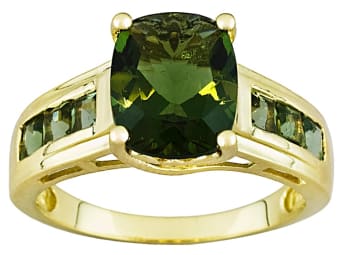Gem Education

Alexandrite:
Alexandrite, with its chameleon-like qualities, is a rare variety of the mineral chrysoberyl. Its color can be a lovely green in daylight or fluorescent light, changing to brownish or purplish red in the incandescent light from a lamp or candle flame. This is a result of the complex way the mineral absorbs light.
Alexandrite is also a strongly pleochroic gem, which means it can show different colors when viewed from different directions. Typically, its three pleochroic colors are green, orange, and purple-red. However, the striking color change doesn’t arise from the gem’s pleochroism, but rather from the mineral’s unusual light-absorbing properties.
Because of its scarcity, especially in larger sizes, alexandrite is a relatively expensive member of the chrysoberyl family. It shares its status as a June birthstone with cultured pearl and moonstone.
FUN FACTS:
1830
The year alexandrite was discovered in Russia’s Ural Mountains.
CZAR ALEXANDER II
Gem’s namesake who emancipated Russia’s serfs and was assassinated in 1881.
580NM
This absorption band allows alexandrite to shift from red to green when viewed under different light sources.
- Mineral: Chrysoberyl
- Chemistry: BeAl2O4
- Color: Bluish green in daylight, purplish red in incandescent light
- Refractive Index: 1.746 to 1.755
- Birefringence: 0.008 to 0.010
- Specific Gravity: 3.73
- Mohs Hardness: 8.5
BIRTHSTONES & ANNIVERSARIES
Alexandrite is a birthstone for June, along with pearl and moonstone. Alexandrite is also the gem for the 55th wedding anniversary.
WHY WE LOVE THIS GEMSTONE
1.- COLOR CHANGE
Making alexandrite change color from green to red is the world’s most fun use of a penlight.
2.- LIGHT SOURCE
This gem provides dramatic proof of how much the light source affects color in gems.
3.- PHENOMENA
Alexandrite can show both color change and a cat’s-eye: two phenomena in one gem.

Amber:
Amber is nature’s time capsule. This fossilized tree resin contains remnants of life on earth millions of years ago. Amber is an organic gem. Organic gems are the products of living or once-living organisms and biological processes. Amber formed tens of millions of years ago, when sap from ancient trees hardened and fossilized.
Scientists and collectors treasure amber that contains suspended animal or plant fragments. These fossilized bits of once-living things were trapped in the hardening amber, creating a fascinating time capsule.
Some types of amber are found in the ground. Other types have been freed and carried by tides, ending up on beaches or near-shore areas. The Baltic coast bordering Germany, Poland, and Russia is still an important source of amber.
Amber is sometimes called “gold of the North.” Its warm luster is featured in beads, carvings, pendants, and cabochons, as well as decorative items like cups, bowls, snuff boxes, and umbrella handles.
A related material, called copal, is also fossilized tree resin, but it’s far younger than amber, at less than a million years old.
The Greeks called amber elektron, or “made by the sun.” Homer praised its bright glow. The Egyptians buried it in tombs for the afterlife. Today’s scientists value amber too: it provides a three-dimensional window into prehistoric ecosystems through the myriad animal and plant inclusions it contains.
FUN FACTS
320 MILLION
The oldest amber dates to the Upper Carboniferous Period (approximately 320 million years ago).
6 TONS
The Amber Room, a 1716 gift presented to Russia’s Peter the Great, was made from six tons of amber.
TIME CAPSULE
1,000 extinct animal species as well as various types of plant matter have been identified in amber.
- Organic, not mineral: Fossilized resin
- Chemistry: C10H16O
- Color: Yellow, orange, and brown
- Refractive index: 1.540
- Specific gravity: 1.08
- Mohs Hardness: 2.0 to 2.5
BIRTHSTONES & ANNIVERSARIES
While amber isn’t a birthstone, it is associated with the astrological sign of Taurus.
WHY WE LOVE THIS GEMSTONE
With inclusions like insects, lizards, leaves, flowers, and feathers, amber helps scientists study ancient ecosystems.
Although the movie Jurassic Park is fiction, scientists extracted DNA from insects enclosed in 120-million year old amber.
Amber smells good when you rub it. Although an oil made from burned amber was used in scents in ancient times, it isn’t used in perfume today.

Amethyst:
Amethyst was as expensive as ruby and emerald until the 19th Century, when Brazil’s large deposits were discovered. It was believed to prevent intoxication—amethystos means “not drunk” in ancient Greek. Today, as the most valued quartz variety, amethyst is in demand for designer pieces and mass-market jewelry alike, and its purple to pastel hues retain wide consumer appeal.
Amethyst is the purple variety of the quartz mineral species. It’s the gem that’s most commonly associated with the color purple, even though there are other purple gems such as sapphire and tanzanite. Its purple color can be cool and bluish, or a reddish purple that’s sometimes referred to as “raspberry.”
Amethyst’s purple color can range from a light lilac to a deep, intense royal purple, and from brownish to vivid. Amethyst also commonly shows what is called color zoning, which in the case of amethyst usually consists of angular zones of darker to lighter color.
FUN FACTS
ST. VALENTINE
The patron of romantic love wore an amethyst ring carved with the image of Cupid.
CAMILLO LEONARDI
The astrologer wrote that amethyst quickens intelligence and gets rid of evil thoughts.
164 POUNDS
Single amethyst crystals can be huge: the GIA Museum displayed a doubly terminated crystal that weighed 164 pounds.
- Mineral: Quartz
- Chemistry: SiO2
- Color: Purple
- Refractive Index: 1.544 to 1.553
- Birefringence: 0.009
- Specific Gravity: 2.66
- Mohs Hardness: 7
BIRTHSTONES & ANNIVERSARIES
Amethyst is the birthstone for February and the gem for the 6th and 17th wedding anniversaries.
WHY WE LOVE THIS GEMSTONE
In gem localities like Brazil, amethyst sometimes forms in hollow, crystal-lined geodes so big you can stand in them.
Even fine amethyst has a modest price tag. Large gems remain affordable as price per carat does not rise dramatically with larger size.
In Bolivia, amethyst and citrine occur in the same crystal. The unique gems, called ametrine, are half purple and half yellow.

Ametrine:
Ametrine, one of the rarest types of transparent quartz, combines two colors: amethyst’s purple and citrine’s orange-to-yellow, growing together in a single crystal.Transparent, bicolored quartz with the colors of both amethyst and citrine in the same gem is called ametrine or amethyst-citrine. The contrasting colors give it an intriguing appearance.
Fine ametrine shows medium dark to moderately strong orange, and vivid to strong purple or violetish purple. Larger gems, usually those over 5 carats, tend to show the most intensely saturated hues. Dealers look for an attractive half-and-half distribution of each color, with a sharp boundary between the two colors at the center of the fashioned gemstone.
Ametrine is often cut as a rectangular step cut because that style nicely displays the bicolor effect. Cutters try to emphasize both colors equally.
FUN FACTS
NO PLACE ELSE
There is only one commercial source for ametrine: the Anahi mine in Bolivia.
NATURE’S GIFT
The presence of amethyst and citrine colors in a quartz crystal is a rare gift of nature.
CUTTER’S CHOICE
Ametrine’s colors blend, combine, and contrast uniquely in each gem.
- Mineral: Quartz
- Chemical composition: SiO2
- Color: Bicolor orange/yellow and purple
- Refractive index: 1.544 to 1.553
- Specific gravity: 2.66 (+0.03/-0.02)
- Mohs hardness: 7
WHY WE LOVE THIS GEMSTONE
No two ametrines look the same because the colors in each gem combine in a unique way.
There’s only one commercial source of ametrine, so the supply is very limited.
Cutters delight in finding ways to maximize the beauty of ametrine.

Aquamarine:
Blue to slightly greenish-blue variety of the mineral beryl. Crystals are sometimes big enough to cut fashioned gems of more than 100 carats. Well-formed crystals might make superb mineral specimens.
Aquamarine’s name comes from the Latin for seawater and it was said to calm waves and keep sailors safe at sea. March’s birthstone was also thought to enhance the happiness of marriages. The best gems combine high clarity with limpid transparency and blue to slightly greenish blue hues. Like many beryls, aquamarine forms large crystals suitable for sizable fashioned gems and carvings.
FUN FACTS
110 KILOS
The largest gem-quality aquamarine crystal mined to date is 19 inches long.
BERYL
Like emerald, aquamarine is a color variety of the mineral beryl.
15,000 FEET
Aquamarine is mined at high elevations in Pakistan’s Karakoram Mountains.
- Mineral: beryl
- Chemistry: Be3Al2Si6O18
- Color: greenish blue, light in tone
- Refractive index: 1.577 to 1.583
- Birefringence: 0.005 to 0.009
- Specific gravity: 2.72
- Mohs Hardness: 7.5 to 8.0
BIRTHSTONES & ANNIVERSARIES
Aquamarine is the birthstone for March and the gem of the 19th wedding anniversary.
WHY WE LOVE THIS GEMSTONE
Aquamarine grows in beautiful six-sided prismatic crystals that on rare occasions can be more than a foot long.
Faceted aquamarine is often exceptionally transparent with vitreous luster,
so it really sparkles.
Using a dichroscope, you can see aquamarine is near colorless and stronger blue in different crystal directions.

Citrine:
Citrine's color comes from traces of iron. It’s perhaps the most popular and frequently purchased yellow gemstone and an attractive alternative for topaz as well as for yellow sapphire.
Citrine is rare in nature. In the days before modern gemology, its tawny color caused it to be confused with topaz. Today, its attractive color, plus the durability and affordability it shares with most other quartzes, makes it the top-selling yellow-to-orange gem. In the contemporary market, citrine’s most popular shade is an earthy, deep, brownish or reddish orange.
Since natural citrine is rare, most of the citrine on the market is the result of heat treatment, which causes some amethyst to change color from undesirable pale violet to an attractive yellow. The amethyst’s original hue can determine the richness of the resulting citrine’s yellow color.
FUN FACTS
IRON
A trace of iron in citrine’s structure is responsible for its yellow-to-orange color.
HEAT
Natural citrine is rare. Most citrine on the market is the result of heat treatment of amethyst.
POPULAR
Citrine is recognized as one of the most popular and frequently purchased yellow gemstones.
- Mineral: Quartz
- Chemical composition: SiO2
- Color: Yellow to orange to orangy red
- Refractive index: 1.544 to 1.553
- Specific gravity: 2.66 (+0.03/-0.02)
- Mohs hardness: 7
BIRTHSTONES & ANNIVERSARIES
Along with topaz, citrine is a birthstone for November. It’s also recognized as the gem that commemorates the thirteenth anniversary.
WHY WE LOVE THIS GEMSTONE
Even fine citrine has a modest price tag. Large gems remain affordable, as price per carat does not rise dramatically for larger sizes.
Giant hollow crystal-lined amethyst geodes from areas like Brazil are often heated to become giant citrine “cathedrals.”
In Bolivia, amethyst and citrine colors can occur together in the same crystal. These unique gems are called ametrine.

Diamond:
Diamonds are among nature’s most precious and beautiful creations, this hardest gem of all is made of just one element: carbon. It’s valued for its colorless nature and purity. Most diamonds are primeval—over a billion years old—and form deep within the earth.
Diamond forms under high temperature and pressure conditions that exist only about 100 miles beneath the earth’s surface. Diamond’s carbon atoms are bonded in essentially the same way in all directions. Another mineral, graphite, also contains only carbon, but its formation process and crystal structure are very different. Graphite is so soft that you can write with it, while diamond is so hard that you can only scratch it with another diamond.
Fun Facts
58X HARDER
Diamonds are the hardest material on earth: 58 times harder than anything else in nature.
“LUCY” IN THE SKY
Fifty light years from earth, this star is a 10 billion-trillion-trillion carat diamond.
1 IN 1,000,000
The average yield in most diamond mines is 1 part diamond to 1 million parts host rock.
- Mineral: Diamond
- Chemistry: C
- Color: Colorless
- Refractive Index: 2.42
- Birefringence: None
- Specific Gravity: 3.52 (+/-0.01)
- Mohs Hardness: 10
BIRTHSTONES & ANNIVERSARIES
On almost all modern birthstone lists, diamond is recognized today as the birthstone for April. Diamond is also the gem that marks the 60th and 75th wedding anniversaries.
WHY WE LOVE THIS GEMSTONE
GLOBAL LANGUAGE
The 4Cs, created by GIA, are considered the global language of diamond quality.
CARBON
Diamond is the only gem composed of one single element: carbon.
A BILLION YEARS
Most diamonds formed more than a billion years ago, deep in the earth’s mantle.
Moldavite:
What is moldavite?
Moldavite is a type of tektite, which is gemstone material created by meteorite impacts on earth. The force of these meteorite impacts instantly melt surrounding soil and rock, creating molten glass. This molten glass is then flung into the air where it cools as it falls to the ground.

What are tektites?
Tektites are classified by their fairly similar form, which is predominantly made of silica glass called lechatelierite. Lechatelierite earns its name from a lack of several items, including water or other volatiles, microscopic crystals, and a lack of chemical relation to the local sediments where they are found.
Where is moldavite found?
Tektites occur in what are known as strewn fields. Strewn fields are the resting places for material ejected from meteorite craters. Moldavite is currently found anywhere from over 150 to 280 miles away from the Nördlinger Ries impact crater in Germany. This is a large impact crater that is almost 15 miles across with a depression visible on aerial photos.

Rough Moldavite
Where are strewn fields?
From the Nördlinger Ries impact crater, there are four main strewn fields: southern Bohemia and southern Moravia (both in the Czech Republic), Waldviertel (Austria), and Lausitz (eastern Germany). The most famous moldavite deposits are in southern Bohemia near České Budějovice where moldavite is found in sand pits near Ločenice and Vrábče. It is also found in a clay pit near Besednice.
What are the colors of moldavite?
Moldavite is not only unique in its origin from other gemstones, but it also differs in color, shape and size among other specimens. When it comes to color, moldavite can range from brown to olive green to brighter bottle green. Moldavite’s colors can also be loosely related to different strewn fields. For instance, gemstones from the Czech Republic that are more bottle green and transparent are typically from the southern Bohemian sites. Olive green to brown moldavite is typically from southern Moravia, near Brno. Southern Moravian moldavite is not only more brown in color on average, but it's normally much larger in size than Bohemian moldavite.
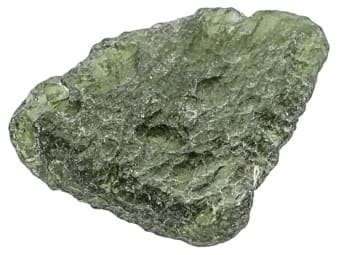
What are the shapes and sizes of moldavite?
Moldavite can come in many shapes but is not typically large. The largest piece ever found weighs 238 grams or about a half pound. Compared to other well-known gemstones, this is tiny. One of the largest topaz gemstones, called the Adiël Topaz, weighs over 20,000 carats which is almost 9 pounds. While moldavite sizes may not be as impressive as some gemstones, moldavite can take on a few interesting shapes from how they form.
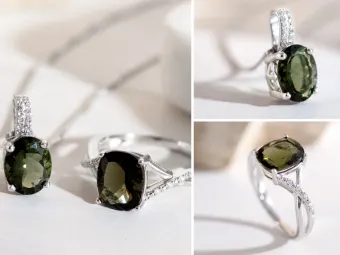
What are splash forms?
Moldavite shapes, called splash forms, make this uncut gemstone highly collectible. Moldavite splash forms can be shaped like disks, drops, ellipsoids, spheres or dumbbells. Other moldavite may be partially formed shapes like a bar that was once part of a drop. These splash forms are determined by centrifugal force and surface tension, as well as atmospheric pressures flattening or stretching the glass before it cooled.
Depending on how far a moldavite traveled also affects the surface structure of the moldavite. Those that did not travel as far will have very little surface changes, while those that traveled farther will show some separation or cracking of the surface. For some tektites, they traveled so far that the effects of the atmosphere were similar to what meteorites experience.
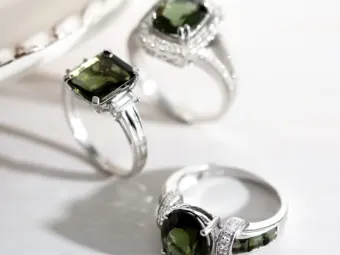
Thankfully, moldavites are somewhat near their impact site as beautiful specimens rather than burned pieces from reentry. Some of the most sought-after moldavites are also extremely weathered resulting in surface etching. Those from Besednice are especially etched and are affectionately called hedgehogs because they appear prickly.
How long will moldavite last?
Moldavite is an interesting stone with an incredible journey, but it may not be readily available for future generations. Since it was created from a meteorite impact millions of years ago, those conditions are impossible to recreate. Not only that, but because it’s from a strewn field located in a specific area and strata, once the stones have been mined out, there is no possible way to find it somewhere else in the world.
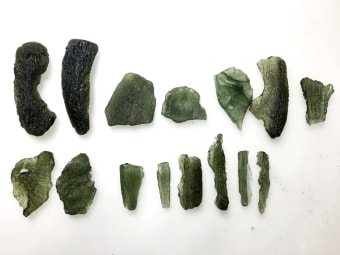
Where is moldavite mined?
Today, there is only one operating mine in the Czech Republic that produces moldavite in commercial quantity. With the current levels of production, it is estimated that moldavite will be completely mined out in the next ten years.
Another deposit located in Brusná has been mined out and is being prepared for cultivation. Mines in Ločenice and Nesměň are not currently in operation but could resume in the future. The production and supply of moldavite appears unsettled at this time.
What is moldavite's healing and spiritual properties?
Moldavite is not only geologically a fascinating stone, but there are many metaphysical properties about it. Since moldavite carries both terrestrial and stellar energies, it is typically seen as a very high-energy stone and believed to be a source of connectivity. Those that believe in moldavite’s spiritual properties use it to accelerate their personal and spiritual growth. It is even seen as a token of good fortune that can grant wishes and protection from dark energies for those who wear it.
Regardless of having spiritual energy or not, moldavite has amazing geological qualities, and will never cease to fascinate humankind in one form or another
